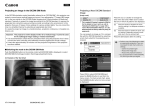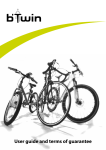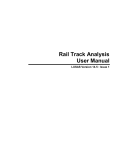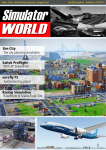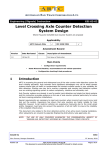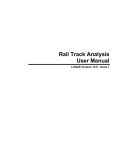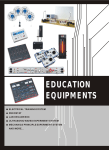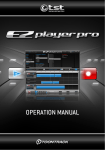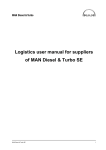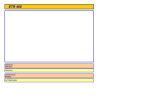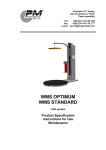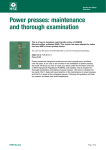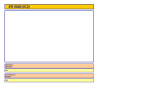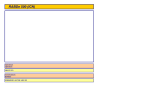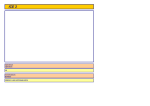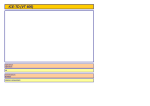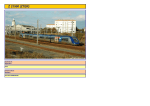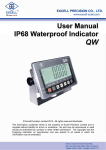Download Driver`s Rule Book Shunting
Transcript
Leonardo Driver's Rule Book Shunting Document for use by train drivers Impressum Editor: Editorial deadline: Product number: Copyright The Leonardo Project owns the copyright as well as all exploitation rights to the documents. The following partners are participating in the project: Belgian Railways (SNCB) German Railways (DB Training) French Railways (SNCF) Austrian Railways(ÖBB Traktion) Polish Railways (PKP Cargo) Czech Railways (CD) University of Würzburg (IZVW) The documents may not be reproduced, distributed, publicly communicated, modified or otherwise altered. SNCF, Student Manual, Version 1.0 Shunting Page I Contents Chapter 1 GENERAL ................................................................................................ 3 1.1 Shunting Instructions................................................................................................3 1.2 Driving the motive power unit ......................................................................................3 1.2 1.3. Signals displayed by the vehicles shunted........................................................4 2 Chapter 2 SHUNTING COMMANDS .................................................................. 4 2.1. Form of shunting commands......................................................................................4 2.2. Code of shunting commands......................................................................................4 2.3. Giving shunting signals. .............................................................................................8 Chapter 3 PERFORMING SHUNTING OPERATIONS ............................................. 8 § 1. Operations before starting to move ................................................................. 8 3.1. Information to be provided..........................................................................................8 3.2. Preliminary precautions concerning vehicles to be shunted. .....................................9 3.3. Safety of people in the vicinity....................................................................................9 3.4. Prior checks and agreements regarding the shunting route.......................................9 3.5. Points operated on the spot. ....................................................................................10 § 2. Provisions applicable during the shunting process..................................... 10 3.6. Order to start moving................................................................................................10 3.7. Performing the shunting operation. ..........................................................................11 3.8. Measures to be taken at the end of the operation....................................................12 Chapter 4 RADIO-CONTROLLED SHUNTING OPERATIONS .............................. 13 4.1. General.....................................................................................................................13 4.2. Placing in service. Tests...........................................................................................13 4.3. Information to be given to the driver.........................................................................13 4.4. Order to start moving................................................................................................14 4.5. Performing the shunting operation. ..........................................................................14 4.6. Radio link involving more than two people. ..............................................................15 4.7. Radio malfunction.....................................................................................................15 4.8. Emergency call signal. .............................................................................................16 Chapter 5 SPECIAL PROVISIONS ......................................................................... 16 5.1. Passenger train banking. Bringing up to the platform. .............................................16 5.2. Hump shunting (by gravity). .....................................................................................17 5.3. Shunting stabled motive power units........................................................................17 5.4. Vehicle movements guided as though they were shunting operations. ...................17 Chapter 6 STOPPING AND SECURING ................................................................. 18 6.1. Braking. ....................................................................................................................18 6.2. Stabling vehicles and trainsets.................................................................................18 6.3. Drag shoes ...............................................................................................................19 6.4. Stop blocks...............................................................................................................19 Page II SNCF, Student Manual, Version 1.0 Shunting This document sets out the general provisions that apply to shunting. Chapter 1 GENERAL 1.1 Shunting Instructions Shunting Instructions should be drawn up in each establishment where shunting operations are carried out other than in purely exceptional circumstances. For establishments on plain track and remote-controlled stations, the content of these instructions is given in the service manual, which then replaces the Shunting Instructions. The Shunting Instructions are the reference document for all operators likely to provide services on any given site. Its provisions should therefore be familiar to all staff involved in shunting, with the exception of drivers not regularly assigned the task of performing shunting operations in the yard concerned. The organisational arrangements and any special equipment (radio, mobile automatic brake control device, remote-controlled motive power unit, etc.) used by each operator are described in the instructions. The person in charge of the shunting operation, and duly authorised for such purposes, is referred to in this Rule Book as the "shunting inspector" and is in a position of authority in relation to other staff involved in the procedure, driver included. The shunting inspector may pick one member of the shunting crew (who may board the trainset if appropriate) to guide the operation to be carried out. Choosing someone to fulfil this function must not occur while the vehicle is moving. Additional provision When the shunting inspector has to be replaced during a shunting operation, he should assign one of the other members of the crew to this role. The changeover should only occur when the train or vehicle comes to a stop and shall bring the first shunting process to an end. 1.2 Driving the motive power unit The motive power units used to conduct shunting operations are equipped for driver only operation. In some establishments shunting operations may only be performed with a motive power unit controlled from the ground or from a vehicle offering the requisite visibility, in view of the various things that the person controlling operations must be able to see. The conditions in which the different shunting operations should be conducted are stipulated in Instructions. When the operator controlling the motive power unit has boarded the train or positioned himself in front of it and has a clear view of the part of the track that is to be covered and the signals to be kept in sight throughout the operation, the latter is considered to be an operation with the driver in front. SNCF, Student Manual, Version 1.0 Shunting Page 3 1.2 1.3. Signals displayed by the vehicles shunted. During nightime shunting operations in the establishments, the motive power units must show at least one white light at each end. When the signals are likely to be used under several different operating systems, the system of head lights should be used. In tunnels, vehicles being banked should show a white light at the front. Similar arrangements may be called for under other circumstances and stipulated accordingly in the Shunting Instructions. 2 Chapter 2 SHUNTING COMMANDS 2.1. Form of shunting commands. Shunting commands are issued: - either by radio (or equivalent): using voice communication or audible "beeps" (cf. Chapter 4). - or using the conventional optical shunting signals: − installed permanently: SNCF-type colour-light shunting signals (SLM), indicator boards for converging tracks (TLC), regional signal types, etc. − manual, backed if necessary by audible signals; - or using voice commands. 2.2. Code of shunting commands The main commands to be given to the driver are the following: - haul - bank - slow down - stop - close up Where the "haul" and "bank" commands are concerned, the corresponding direction of movement is established as follows: When the motive power unit is coupled to a vehicle or at the end of a raft of vehicles, the motive power unit "hauls" when, in relation to the direction of movement, it precedes the other vehicle(s); it "banks" when it is following the other vehicle(s). When the tractive unit is alone or in-between vehicles, "Haul" indicates that the driver should move his train away from the crew member who gave the signal; "Bank" tells him that he should move towards this person. The crew member making the signals has to reverse his signals as the motive power unit passes in front of him. Page 4 SNCF, Student Manual, Version 1.0 Shunting Additional provision - when the motive power unit has two driver's cabs, the commands are transmitted to the driver without taking account of the cab in which he is located; - when in a trainset (push-pull, railcar, motor coach trainsets, series of locomotives coupled together as a multiple unit or one locomotive hauling one or several other locomotives), the power or trailer car at each end has a driver's cab, so the vehicle occupied by the driver represents the power car and the other vehicles are considered as trailers. COMMAND SNCF, Student Manual, Version 1.0 Shunting DAY NIGHT Rolled up flag or arm raised vertically Lamp with white light raised vertically AUDIBLE SIGNAL (1) Page 5 HAUL BANK SLOW DOWN STOP CLOSE UP Page 6 upwards several upwards several times times Rolled up flag or arm Lamp with white light hanging horizontally hanging horizontally towards the bottom of the body The BANK signal should continue throughout the duration of the operation. Rolled up flag or arm White light shown held horizontally with and slight waving a slight vertical movement waving movement Red light shown or, Red flag unrolled or failing this, any light both arms raised as waved violently high as possible, or arm or object waved violently Both hands raised to White light shown at shoulder level and shoulder level, gently moved moved together and horizontally several then parted several times times Two long blasts Three long blasts Three series of: One long blast followed by a short blast Several short, sharp whistle or horn blasts No audible warning signal SNCF, Student Manual, Version 1.0 Shunting COMMAND HAUL BANK STOP TRANSFER YOUR ATTENTION TO THE HAND SIGNALS SNCF, Student Manual, Version 1.0 Shunting DESCRIPTION The colour-light shunting signals alternately display two white lights in a vertical line The colour-light shunting signals alternately display two white lights in a horizontal line The colour-light shunting signals are all extinguished The colour-light shunting signals continuously display all three white lights at the same time Page 7 2.3. Giving shunting signals. The shunting inspector should ensure that the shunting signals he gives can be easily perceived by the driver or, where applicable, another member of the crew next to him, who should repeat them to him. He should position himself accordingly or ensure that his commands are repeated by one or several other members of the crew strategically positioned at intermediate points. Orders to slow down and stop should be given sufficiently in advance (especially in the event of banking) to enable proper placement of the corresponding operation, allowing for the time necessary for the message to be passed on by intermediate staff, the train consist, its braking performance where applicable, any gradients, etc. Crew members involved in any particular shunting operation should be able to order this operation to be halted at all times. Chapter 3 PERFORMING SHUNTING OPERATIONS § 1. Operations before starting to move 3.1. Information to be provided. Before starting shunting operations, the shunting inspector should inform his crew: shunters, signalman, driver, etc. in detail about what is to happen. The purpose of this information is to give all crew members involved a way of finding their bearings, so that they can check as things proceed that the operation is taking place according to plan. In particular, the shunting inspector should inform them of: − the successive movements to be performed, − the particular features of these movements: e.g. towards an occupied track, etc. − the position and role of each of the members of the crew involved in the operation, − the number of vehicles to be shunted or the approximate weight and, where applicable, the braking characteristics and the use of the mobile automatic brake control device (AMCFA). The same individuals must be immediately informed of any changes to the original arrangements. Additional provisions 1. The stipulations regarding the information to be given to the driver do not apply in their entirety to those shunting operations (such as train splitting operations in a marshalling yard) that are always carried out under the same conditions. 2. The person in charge of the shunting operation must tell the driver where the final point of his hauling or banking operation should take him and indicate the points at which he will have to obey specific instructions (speed reductions, etc.) and should try to find easily identifiable landmarks so that the driver can: - proceed to carry out the various stages of the operation correctly, Page 8 SNCF, Student Manual, Version 1.0 Shunting - judge the distance he has in which to stop, particularly in relation to the train consist and, where applicable, the braking characteristics. 3. If the shunting operation is carried out using the motive power unit of a train, the information given to the driver should allow for the fact that he may not be familiar with the specific features of the local environment. 4. If the shunting operation includes several phases, the person in charge of the operation may split it into several smaller operations and issue the corresponding instructions before each of these. 5. In the event of a shunting operation being conducted at the rear of a train, the driver of the train must be warned. 6. In the event of a shunting operation at the front of a train including a banking locomotive, the driver of the locomotive should be informed of the beginning and end of the operation and must not push the train until he has been advised that the shunting operation has been completed. 3.2. Preliminary precautions concerning vehicles to be shunted. Before issuing the order to start moving, the person in charge of the operation should ensure that the vehicles are able to be moved. He should, therefore, particularly check or have someone else check that: - the condition of the vehicles and their loads do not make shunting impossible, taking account of any labels and markings on the vehicles, - the brakes are released and the chocks removed, - any vehicles not being shunted will remain stationary, - where applicable, the trainset braking characteristics are sufficient (see Art. 601). 3.3. Safety of people in the vicinity. Before issuing the order to start the shunting operation, the person in charge must make sure that: - all those on board the vehicles themselves or within the gauge of the track concerned (crew, service providers, third parties, etc.) have been warned and their safety ensured, - travelling passengers have been warned that a shunting operation is about to take place. 3.4. Prior checks and agreements regarding the shunting route. Before issuing the order to start the shunting operation, the person in charge must: 1. ensure that the sections of line to be covered are clear and will remain clear until the shunting operation has been completed. He can achieve this: - for those sections of track depending on a signal box and which are released by this signal box, by agreement with the signalman; - for those sections of track not depending on a signal box (or which depend on a signal box but whose release is not controlled by this signal box), by checking that the track is clear and by reaching the necessary agreements to obtain total clearance of the section. 2. take the necessary steps to ensure that the route is set in good time: SNCF, Student Manual, Version 1.0 Shunting Page 9 - when points are operated from a signal box, by agreement with the signalman, - when points are operated on the spot, by checking or having someone else check in good time that the points are correctly set and that the blades are firmly in position. If trailable points are involved, these checks must be carried out when the points are taken in the facing direction. They are not required when the points are forced open by the shunting operation itself and therefore set themselves. Non-reversible trailable points should, however, be set in the correct position in advance if the shunting operation that would force them open does not entirely clear them. Additional provisions 1. The agreement reached with the signalman is confirmed: − when the route to be taken for the shunting operation is set by a particular signal in the track, by the clearance of this signal or by the display of a shunting order in the case of a permanently installed shunting signal; in the absence of such a signal, or if the signal relates to a group of converging tracks, and in the case of a shunting operation against a stop signal, whatever the means of communication involved (radio, telephone, agreed signals, etc.). 2. There is no obligation to ensure that the point blades are firmly in position − if the position of the points concerned has not changed in preparation for the shunting operation, when their position has been checked during a previous operation and when these points have not been forced open since; − if the points concerned are locked or padlocked in position, in other words if they are so-called forced position points (it is then up to the member of staff who fixed the points in this position to check that they are firmly in place). 3.5. Points operated on the spot. 1. The person in charge of setting locally-operated points must check to ensure that they are firmly in position; if such is not the case, he should signal the vehicle to stop. 2. When trailable points have been forced open by the previous operation, the position of these points and the contacts between rail and blade must be checked before allowing a vehicle taking the points in the facing direction to set off on its way. 3. It is forbidden to change the position of the points when a vehicle is in the process of a negotiating them. § 2. Provisions applicable during the shunting process 3.6. Order to start moving. 1. The driver should not start moving to carry out a shunting operation without an express order from the person in charge of the operation (or from the crew member delegated for the purpose). When a stop signal clears, this in itself does not constitute an order to start moving. 2. Before issuing an order to start moving, the person in charge of the operation must be sure that the people required for the operation to be conducted properly are in position and ready to carry out the instructions they will be given. Page 10 SNCF, Student Manual, Version 1.0 Shunting He must also ensure, where applicable, that the aspect displayed by the stop signal governing the shunting operation does not preclude the operation. 3.7. Performing the shunting operation. 1. The driver must be at the front in relation to the direction of movement whenever the circumstances in which the operation is to be performed allow. 2. When performing the manoeuvre, the driver has to proceed under shunting conditions and should set his speed in relation, in particular, to the number of vehicles in the trainset, the brake system at his disposal and the profile of the line. If he notices that the operation is not in line with the information given him during the briefing session, he should not obey the order given but should stop and ask the shunting inspector for further explanations. Any other crew member who notices that the operation is not in line with the original instructions should order the operation to be halted and enquire about the reasons for the change. Additional provisions 1. If the operation is halted by the presence of a signal set at danger, the shunting inspector shall, if necessary, identify himself to the signalman. If the signal at danger is to be passed, the authorisation to do so is given to the driver, if he is at the front in relation to the direction of the movement, and to the person in charge of the operation, if he is not. 2. If the operation is halted in a station by a "shunting limit" board, the person in charge of the operation may only order the driver to pass this board with the authorisation of the traffic controller, unless otherwise stipulated in the Shunting Instructions. 3. When the driver is at the front [the motive power unit (or driver's cab) in which the driver is located is at the head of a movement or is banking a vehicle]: Irrespective of the measures described in paragraph 2 above, the driver conducting a shunting operation, who is travelling on a service track that is part of a set of converging tracks and in the event that this track is not governed by a specific individual signal, should normally stop when he nears the exit before entering the crossings. This provision applies even if he can see that the signal after the crossings and applicable to all or part of the tracks in the set shows clear. The driver is not allowed to start moving again unless he has received a shunting command. However, the driver is dispensed from having to stop at crossings if he has received or receives an order to proceed. In those parts of railway establishments accessible to the public or usually assigned for operations on rolling stock (handling, cleaning, restocking) the driver must proceed with caution watching the track and being ready, where necessary, to attract the attention of people in the vicinity and bring his vehicle(s) to a halt as soon as possible, if he sees that there are people or road vehicles within the gauge of the track on which he is moving. Additional provisions 1. When the driver banks a vehicle and if the layout of the cab(s) is such that he cannot see the signals, it is up to the shunting inspector, or the crew member assigned by him, to take charge of this function, boarding the motive power unit, if appropriate. The same provisions apply if, for service reasons, the driver of a motive power unit with two cabs is located in the car at the rear in relation to the running direction. 2. If, at the exit to the set of converging tracks, there is a converging track board (TLC) or an origin indicator board (TIP), and if these boards show an authorisation to proceed, they will have SNCF, Student Manual, Version 1.0 Shunting Page 11 the equivalent status to the shunting command that dispenses the driver from the need to stop at the crossings. 4. When the driver is not at the front (banking more than one vehicle): - it is the shunting inspector who is responsible for observing the signals and not the driver. It is the inspector who should set the tempo at which the operation is to be performed by issuing stop and slow down instructions to the driver in good time to prevent him bumping too heavily into the vehicles he is approaching, going beyond the fixed limit or hitting a buffer, etc. To this end, the person in charge of the operation should position himself so that he can see the indications or should be in contact with another member of the crew placed, if appropriate, at the front of the trainset and assigned the task of ensuring application of the instructions issued; - the shunting inspector (or the crew member of his choice) should walk ahead of the trainset or stand on the leading vehicle when a banked trainset moves alongside a platform where there are members of the public, or when it moves in those parts of railway establishments accessible to the public or normally reserved for operations carried out on rolling stock (handling, cleaning, restocking). He is responsible for warning those concerned and should, if necessary, order the shunting operation to be halted. The Shunting Instructions may stipulate that a similar position be adopted under other circumstances or may require other specific measures; - for his part, the driver has to execute the orders he receives. He must reduce speed sharply when he receives an order to slow down (when he receives the first order, in the event of successive commands). He must stop if he can no longer perceive the signals given him; - banking manoeuvres ordered by means of hand signals or by radio voice communications must not exceed a speed of 15 km/h. 3.8. Measures to be taken at the end of the operation. 1. At the end of the shunting manoeuvre, the shunting inspector should take action, either himself or via another crew member, to make sure that the vehicles: - do not foul the main tracks and are stabled in front of the movable scotch blocks, derailers, etc.; - are clear of the crossings with adjoining service tracks (allowing for decompression of the buffers following the release of the air brakes); - are fully immobilised. When, exceptionally, the crossings with service tracks are fouled by a stabled vehicle or a trainset, the shunting inspector has to inform the staff concerned or ensure that they are informed (signalman, shunting crew, etc.) and have the crossings protected using signals set from the signal box or hand stop signals. 2. The shunting inspector is responsible for having the different devices (signals, etc.) that have to be left in a particular position put back in place and for returning all safety devices (padlocks, locks, movable scotch blocks, etc.) that have been moved during the operation to their original place. Where relevant, he should do the same for the electrical traction facilities. Page 12 SNCF, Student Manual, Version 1.0 Shunting Chapter 4 RADIO-CONTROLLED SHUNTING OPERATIONS 4.1. General In some railway establishments, the shunting inspector and the driver of a shunting or main-line locomotive may communicate with each other by radio or equivalent means of communication for purposes of carrying out shunting operations. These exchanges take place using a pre-determined frequency. If the motive power unit is not fitted with a radio unit that can be set to this frequency, the shunting inspector will give the driver a portable unit for use throughout the duration of the particular operation. 4.2. Placing in service. Tests. 1. When the shunting inspector gives the driver a portable radio unit, he has to tell him or have someone explain to him how to operate the device in order to set it in the "transmitting" position and return it to the "receiving" position. 2. At the start of each shunting session, irrespective of whether the radio on the motive power unit is the on-board unit or a portable device supplied by the shunting inspector, the inspector has to inform the driver of the expressions that they will each have to use to identify themselves when communicating by radio. Example: "Shunting inspector, radio...", "MPU No...." or "MPU train No.... The conditions for such identification are, where relevant, set out in the Shunting Instructions. Then the shunting inspector and the driver will test their radio communications over a short distance. Example: "Shunting inspector... to MPU train No… Line test. Are you receiving me?" "MPU train No… to shunting inspector... Loud and clear. Out." If the radio unit can be used to transmit audible "beeps", transmission of such beeps is also tested at this point. 4.3. Information to be given to the driver. In addition to the provisions of paragraph 3.1. the following also apply: 1. The information that is given before the start of a shunting operation must be provided in such a way that the driver cannot mistake it for a shunting command. 2. If he is not sure of having understood, the driver should ask for the information received to be repeated. When it is important to call the driver's attention to a particular point (change in instructions previously given, etc.), the shunting inspector should ask the driver to repeat back the information he has received. Example: The shunting inspector: "Shunting inspector to MPU train No.... Delaying transfer 4 coaches to go to occupied adjacent track". Where appropriate, the driver or the shunting inspector: "Repeat back." SNCF, Student Manual, Version 1.0 Shunting Page 13 4.4. Order to start moving. The order given by the shunting inspector to start moving consists of: − the indication of the person to whom the order is directed, − the movement order, − where applicable, information about subsequent movements or details regarding the extent of the operation. When audible "beeps" are transmitted, this is never an order to start moving on its own and can in not way release the driver from the obligation to comply with the measures previously stipulated. Additional provision If radio communications are used, it is not necessary for the driver and the shunting inspector to be constantly in each other's line of vision, but this may prevent the driver from interpreting the orders of the shunting inspector as regards his position in relation to the inspector. The following arrangements should therefore apply: - when the motive power unit is coupled at one end of the trainset, the order to start moving should be given using the regulatory commands: "Haul", "Bank" - when the trainset has a cab at either end, the shunting inspector must ensure that there is no confusion in the direction of the orders he gives, in particular allowing for the physical location of the driver on the train. If necessary, he should inform the driver of the direction of travel; - when the motive power unit is on its own on sandwiched between vehicles, the order given should indicate the direction of travel in relation to a point in space that can be easily located. Examples: " MPU train No... Move (or Go) to...." or, if the limit for the particular movement is not sufficient indication in itself regarding the direction of travel: " MPU train No... Move (or Go) in the direction of….. to….". 4.5. Performing the shunting operation. 1. When the driver is at the front (the motive power unit is at the front of the movement or is banking a vehicle) or if the motive power unit is on its own: He continues the movement, if there is nothing to prevent him from doing so, until: - either he is ordered to stop; - or he reaches the furthest point indicated to him (whereupon he informs the shunting inspector). 2. When the driver is not at the front (banking more than one vehicle): The shunting inspector should apply the provisions of paragraphs 2 and 4 of Article 307 and, should, in addition, give the driver indications to confirm that he can continue to proceed, by keeping him informed him as the process is taking place, in particular when he is approaching the point beyond which he should not travel (crossings, etc.). Such indications are transmitted: - either by voice communications; in which case the maximum speed of travel is 15 km/h ; - or by continuously transmitting rhythmic audible beeps. Page 14 SNCF, Student Manual, Version 1.0 Shunting With this information at his disposal, the driver can proceed with the operation until he receives an order to slow or stop. If the beeps cease and are not followed by receipt of a verbal order, the driver should stop and wait for instructions and, if he does not receive any, ask what to do next. Following a passage at reduced speed, an order authorising the driver to continue his movement should be given before the beeps are broadcast once again. In the last stage of a banking operation, voice communications should be used to instruct the driver to slow down and then keep moving until the vehicle comes to a halt, without the series of beeps beginning again. Transmission of beeps. The order to slow down may be accompanied, if necessary, by an announcement stating the distance still to be covered before reaching a halt. Examples: "20 metres..., 10 metres..., 5 metres ..., 2 metres... (or 3 coaches..., 2 coaches..., 1 coach...) Stop." When a short banking operation is to be performed, in particular to close up vehicles in order to couple them up or uncouple them, the order may, for example, be given in the form: "Close up", "Bump". The above orders are given by voice, immediately after the beeps stop, if beeps are used. 4.6. Radio link involving more than two people. When the staff involved in the shunting operation (shunters, signalman, etc.) are also equipped with radios, the following provisions should apply: - the shunting inspector is the only person authorised to give information and orders to the driver, other than the emergency stop command, which may be given by any member of the crew. The driver should only take account of the moves agreed with the shunting inspector. - However, for a given operation (stopping a train near a buffer, closing up vehicles in a trainset, etc.) the shunting inspector may select a crew member to make the traditional signals or give the driver voice instructions. The shunting inspector should advise the driver accordingly. 4.7. Radio malfunction. If the radio link is thought to be or found to be malfunctioning during a shunting operation, the driver must stop and ask for instructions from the shunting inspector. For his part, if he sees that the movement has been halted without apparent reason, the shunting inspector should switch his radio to "receive", if he has not done so already. If he hears nothing from the driver, he should go towards him or send someone to him to reach the necessary agreement, after first having tried to call him up by radio. Additional provision When the movement halted due to radio problems is a banking movement, it can be completed using hand signals. In the absence of staff to give and repeat these signals and if he has equipment with which to halt the train (mobile automatic brake control device, emergency brake valve, emergency pushbutton), the shunting inspector (or a person selected by him) positioned at the front may SNCF, Student Manual, Version 1.0 Shunting Page 15 restart the banking movement after agreeing on this with the driver, without exceeding a speed of 6 km/h. The shunting inspector can cause the movement to be halted using the air brake, if the need should arise. 4.8. Emergency call signal. Some shunting radios have a device that, when activated: - transmits an emergency call signal (modulated audible signal), - stops reception of the banking beeps, on all radio units switched to the "receive" position on the radio channel concerned. Any crew member in possession of a radio equipped with an emergency call signal should activate the device if he sees that a shunting operation is being performed in dangerous conditions. He should then inform all his colleagues of the reason for the halt and take steps or have steps taken to deal with the situation. On hearing the emergency call signal: - the driver must stop at once and ask for instructions, - the other shunt crew members taking part in the operation or in a position to intervene (signalman, duty manager) should order the operation to be halted and should remain on air to find out the reason for the signal and be informed of any emergency measures that may have to be taken. Chapter 5 SPECIAL PROVISIONS 5.1. Passenger train banking. Bringing up to the platform. When the shunting operation is guided by a crew member positioned on the leading vehicle, this person should have a means of stopping the manoeuvre by activating the brake (mobile automatic brake control device, emergency brake valve, emergency pushbutton) in the following cases: - banking a train with passengers on board or a trainset to be bumped up against a train with passengers on board, - banking a passenger train to bring it up to the platform or passing alongside a platform on which members of the public are present. In addition, the maximum speed of any such movement along the platform should be 15 km/h. The latest point at which the vehicle(s) should be slowed is the beginning of the platform. If the person on the first vehicle has no means of halting the movement from the vehicle at the front, the Shunting Instructions should indicate the procedure to be followed. Page 16 SNCF, Student Manual, Version 1.0 Shunting 5.2. Hump shunting (by gravity). 1. Gravity shunting, which consists of releasing vehicles on a hump so that they will then descend under the effect of gravity and be distributed over the various tracks in a set of sidings, is generally carried out in specially adapted marshalling yards. This type of operation is not banking; it is carried out under local conditions set out in the Shunting Instructions, which, in particular, describe how to use the facilities available on the site: gravity humps, retarders, etc. The operation that consists of bringing together the different rakes of vehicles that have been directed to the same track during hump shunting operations, is not a banking movement either. It is performed under the conditions set out in the Shunting Instructions. 2. Hump shunting of certain types of vehicle (special vehicles, etc.,) or vehicles transporting certain types of commodity (dangerous goods, etc.) is forbidden or subject to special precautions. Such vehicles bear special markings by means of which the shunting crews can identify them. Motive power units must not be hump-shunted. 3. Some vehicles (passenger stock, certain out-of-gauge loads, etc.) are not allowed to be sent over the gravity hump or may only be sent over the hump if special precautions are taken. The vehicles concerned bear special markings to indicate that they are banned from the hump or only allowed there subject to special measures. 5.3. Shunting stabled motive power units. A motive power unit that has been left standing may only be moved under its own steam by an authorised employee. When a motive power unit that is stabled is to be moved other than under its own steam, the driver responsible will be instructed, if he is qualified, to take the necessary steps to move the vehicle and secure it when brought to a halt, where applicable. The Shunting Instructions will indicate, where necessary, what the corresponding measures should be. 5.4. Vehicle movements guided as though they were shunting operations. The driver should be at the front each time the operating conditions allow. If it is impossible for him to position himself so that he has a clear enough view of his surroundings to be able to move the vehicle(s) (other than as part of a shunting operation), he should be guided by a crew member positioned at the front of the train, as he would be in the event of a banking movement. This type of situation occurs in particular when moving trains needed for infrastructure maintenance purposes, in their operation on the works site or in the event of an incident affecting a train on the line. In such cases, drivers should proceed with caution, complying with the rules applicable to shunting. SNCF, Student Manual, Version 1.0 Shunting Page 17 These movements are not subject to the speed restrictions resulting from the shunting commands given by means of voice communications or hand signals. The frequency of the commands given using voice communications may be adapted to the situation. It is the responsibility of the crew member positioned at the front to observe the signals and ensure the track is clear and to set the speed by giving shunting commands to the driver. Chapter 6 STOPPING AND SECURING 6.1. Braking. 1. Shunting operations conducted on main tracks are controlled by use of the continuous brake. The braking capacity required must be at least equal to the brake power of end wagons in relation to the steepest gradient on the section of line to be crossed, for both directions and allowing for the braked weight of the motive power unit. The other shunting operations can be conducted without the vehicle(s) shunted being connected up to the main brake pipe of the motive power unit; however, when ordinary or special passenger vehicles are shunted, they should be brakable whenever possible. 2. In the light of information received, the driver should adjust his speed so that he is in a position to stop using only the brake on the motive power unit, where appropriate, and at the point indicated. The shunting crew should, for its part, give orders to slow or stop in sufficiently good time. 6.2. Stabling vehicles and trainsets. The shunting inspector and his crew must take steps to ensure that individual vehicles, trainsets or parts of trains stabled during or after a shunting operation cannot be set accidentally in motion, through the effect of their own weight on a slope, because of the wind, impact, etc. To this end: 1. During shunting: - vehicles or trainsets left at rest on their own during shunting have to be maintained stationary in accordance with the rules set out in the Shunting Instructions. This rule may only be waived if these vehicles or trainsets are to be part of another shunting operation immediately afterwards and if there is no likelihood of their being set in motion because of local conditions (direction of the gradient, etc.). - the part of the train separated from the motive power unit and not being shunted (1) (end of train stabled during the service, for example) is made stationary by opening the stop cock of the main brake pipe until the pipe has completely emptied and by placing a stop block or by applying the hand brake on at least one vehicle; 2. At the end of the shunting operation, the vehicles or trainsets left standing are made stationary under the conditions set out in paragraph 3 below; if the air brake is working, a stop cock is opened until the main brake pipe has completely emptied and is left open. Page 18 SNCF, Student Manual, Version 1.0 Shunting 3. To make the vehicles stationary independently of the air brake, use is made of stop blocks and hand brakes. The proportion of axles to be scotched or braked is as follows: ACTUAL GRADIENT MINIMUM PROPORTION OF AXLES TO BE SECURED not more than 2 mm/m 0 axle greater than 2 mm/m without exceeding 5 mm/m 1 axle in total greater than 5 mm/m without exceeding 16 mm/m 1/10 of the axles greater than16 mm/m without exceeding 25 mm/m 2/10 of the axles greater than 25 mm/m 3/10 of the axles 6.3. Drag shoes The purpose of the drag shoe is to slow down and, if necessary, halt vehicles allowed to run free under the effect of gravity. They may only be used on some service tracks (tracks in gravity shunting yards), under the conditions set out in the Shunting Instructions. 6.4. Stop blocks. Stop blocks serve to maintain stabled vehicles stationary. They must not be used instead of drag shoes to stop a moving vehicle. Stop blocks must be removed before the vehicle is allowed to start moving. SNCF, Student Manual, Version 1.0 Shunting Page 19





















